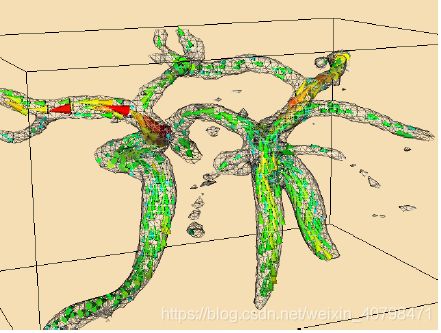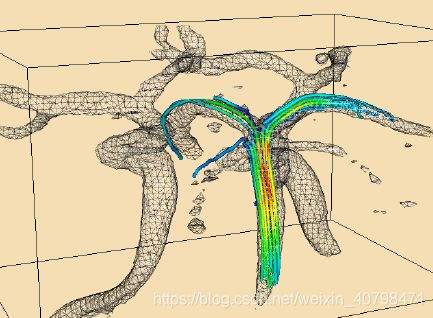- python 数据可视化TVTK库安装与使用
范哥来了
信息可视化python开发语言
TVTK(Traits-basedVisualizationToolKit)是一个基于Python的可视化库,它为VTK(VisualizationToolkit)提供了一个更易于使用的接口。VTK本身是非常强大的可视化工具,但使用起来可能稍微复杂一些,而TVTK通过简化API来提高易用性。下面我将指导您如何安装TVTK以及一个简单的示例来展示其基本用法。安装TVTKTVTK可以通过pip轻松安装
- 8、基于osg引擎实现读取vtk数据通过着色器实现简单体渲染(2)
不收藏找不到我
着色器着色器c++开发语言
#include#include#include#include#include#include#include#include#include#include#include#include#include#include#include#include#include#include#include#include#includeconststd::stringDATA_PATH=R"(..\
- 7、基于osg引擎实现读取vtk数据通过着色器实现简单体渲染(1)
不收藏找不到我
着色器着色器
1、顶点着色器代码#version110/*GLSL1.10需要显式声明精度(OpenGLES要求)*/#ifdefGL_ESprecisionhighpfloat;#endif//体数据采样步长uniformfloatxStepSize,yStepSize,zStepSize;//体数据纹理和颜色纹理uniformsampler3DbaseTexture;uniformsampler1DtfTe
- python mayavi_python下安装mayavi其实并不难
weixin_40009472
pythonmayavi
首先,也是最最重要的一点:不要直接在windows的命令窗口下运行直接网络安装的命令,一定要去网站上(https://www.lfd.uci.edu/~gohlke/pythonlibs/#mayavi)直接下载相关的四个whl类文献,他们是PyQt4、traits、VTK和mayavi。要考虑到版本号的对应关系,比如我下载的是1.PyQt4-4.11.4-cp36-cp36m-win_amd64
- VTK笔记- 3D Widget类 vtkSplineWidget 样条部件
恋恋西风
VTK笔记
vtk3DWidget vtk3DWidget是用于3D交互观察器的基类,也就是各种3D小部件类的基类,主要是在三维渲染场景中生成一个可以用于控制数据的可视化实体,比如点,线段(曲线)、平面、球体、包围盒(线框)等这些3D小部件在场景中表示它们自己,并且具有与它们相关联的特殊回调,允许对小部件进行交互式操作。特别是,vtk3DWidget与其抽象超类vtkInteractorObserver之间
- Python库 - Mayavi
司南锤
PYTHON库python开发语言
Mayavi是一个用于科学数据可视化的Python库,特别适用于三维数据的可视化。基于VTK(VisualizationToolkit)库,提供了简单易用的接口来创建复杂的三维图形。Mayavi可以用于绘制各种类型的三维图形,如点云、曲面、体积数据等,并且支持交互式操作。文章目录安装Mayavi基本概念基本用法1.创建一个简单的三维图形2.绘制点云3.绘制等值面4.交互式操作高级用法1.使用模块和
- 交互开发---测量工具(适用VTK或OpenGL开发的应用程序)
伍心
VTK-医学图像处理c++visualstudio开发语言microsoft软件工程
简介:经常使用RadiAntDICOMViewer来查看DICOM数据,该软件中的测量工具比较好用,就想着仿照其交互方式自己实现下。后采用VTK开发应用程序时,经常需要开发各种各样的测量工具,如果沿用VTK的widgets的思路,绘制出来的的控件不够漂亮,且交互不太灵活,并且随着测量工具的增强,渲染的效率也会有所降低。基于上面的原因,就仿照RadiAntDICOMViewer的交互封装了一个DLL
- vtk坐标标尺的标注
南山五味子
数学建模信息可视化html
//pRenderervtkNewpRenderer;pRenderer->AddActor(pActor);pRenderer->SetActiveCamera(pCamera);pRenderer->ResetCamera();{vtkNewpCubeAxesActor;pCubeAxesActor->SetCamera(pRenderer->GetActiveCamera());//轴的设置
- SAM应用:医学图像和视频中的任何内容分割中的基准测试与部署
烧技湾
AI&ComputerVisionSAMMED2SAN医学图像分割分割一切
医学图像和视频中的任何内容分割:基准测试与部署目录摘要:一、引言1.1SAM2在医学图像和视频中的应用二.结果2.1数据集和评估协议2.2二维图像分割的评估结果三讨论四局限性和未来的工作五、方法5.1数据来源和预处理5.2微调协议5.3评估指标总结关键字:SAM、分割一切基础模型、医学图像、视频、多模态最近医学分割模型发展迅速,基于SAM的医学图像处理得到了进一步的发展。为了追踪医学图像处理的最新
- VTK vtkActor和vtkImageActor的区别
雅俗共赏100
c++算法图像处理
1、vtkActor用途:vtkActor是一个通用的图形渲染对象,可以用于渲染几何数据,如多边形、线条、点等。数据类型:通常与vtkPolyData一起使用,该数据结构可以存储点、线、面和多边形等几何信息。功能:a、支持变换操作(平移、旋转、缩放)。b、支持应用材质、颜色和纹理。c、支持复杂的渲染属性设置,例如光照、阴影等。2、vtkImageActor用途:vtkImageActor专门用于渲
- ️ 总览:TotalSegmentator - 医学影像分割的革新者
金斐茉
️总览:TotalSegmentator-医学影像分割的革新者TotalSegmentatorToolforrobustsegmentationof>100importantanatomicalstructuresinCTimages项目地址:https://gitcode.com/gh_mirrors/to/TotalSegmentator在医学图像处理领域中,精确且高效的自动分割工具对于研究和
- VTK知识学习(32)-图像运算
无所谓จุ๊บ
VTK学习VTK
1、数学运算vklmageMathematics提供了基本的一元和二元数学操作。根据不同的操作,需要一个或者两个输入图像。二元数学操作要求两个输入图像具有相同的像素数据类型和颜色组分。当两个图像大小不同时,输出图像的范围为两个输入图像范围的并集,并且原点和像素间隔与第一个输入图像保持一致。privatevoidTestMathematics(){//绘制一个暗红色矩形vtkImageCanvasS
- vtk文件格式解析
西安光锐软件
c++VTKvtk
了解vtk文件内容后,才能做一些文件格式转换问题,比如.vtk.off文件互转,之前我写过一篇有兴趣的可以参考。这里详细解读vtk文件格式。vtk三维模型的数据主要包括:点point、线edge、面surface,点线面的属性scalar,颜色表lookuptable,下面以polydata数据格式为例:#vtkDataFileVersion3.0//文件格式版本vtkoutput//标记信息,为
- vtkCamera类的Dolly函数作用及相机拉近拉远
荆楚闲人
VTKvtkCameraDollySetFocalPoint
录1.预备知识1.1.相机焦点2.vtkCamera类的Dolly函数作用3.附加说明1.预备知识要理解vtkCamera类的Dolly函数作用,就必须先了解vtkCamera类表示的相机的各种属性。 VTK是用vtkCamera类来表示三维渲染场景中的相机。vtkCamera负责把三维场景投影到二维平面,如屏幕、图像等。在VTK中,相机的实质是一个观测点,与人眼的功能相同,相机的视野范围是一个
- VTK之vtkLight
浩瀚之水_csdn
三维图像vtk
vtkLight是VTK(TheVisualizationToolkit)中用于代表现实场景中灯光的一个类。在三维渲染场景中,灯光是必备的要素之一,它为场景提供照明,使得渲染出来的图像更加逼真和立体。以下是对vtkLight的详细介绍:一、灯光类型vtkLight可以分为两种类型:位置灯光(PositionalLight,也叫聚光灯)和方向灯光(DirectionLight)。位置灯光:光源位置在
- DICOM标准详解
浩瀚之水_csdn
三维图像dcm
DICOM(DigitalImagingandCommunicationsinMedicine)标准是医学图像和相关信息的数字图像通信的国际标准。以下是DICOM标准的详细内容:一、概述DICOM标准由医学图像处理和通信的专业组织DICOM标准委员会(DICOMStandardsCommittee)负责维护和更新。它定义了医学影像设备(如X射线、CT扫描、MRI等)生成、存储、传输和显示的规范,以
- vtkAssembly 装配关系获取
和光同尘 、Y_____
OCC+VTK算法开发语言c++
在装配中VTK没有给方法获取父项或者模型在世界坐标矩阵的获取。通过vtkAssemblyPath::AddNode()可以记录装配关系。1、添加装配-每次装配添加(AddAssemblyPartNew)同时添加vtkAssemblyPaththis->m_render->AddActor(theAssembly);RotateXYZNew(partId,Matrix[3],Matrix[4],Ma
- 第十五节《OpenCascade集成VTK》
《雨声》
OpenCasCade入门学习算法c++交互
将OpenCascade集成到VTK(VisualizationToolkit)中,可以充分利用两者的强大功能:OpenCascade强大的几何建模能力和VTK强大的可视化能力。通过这种集成,用户可以在VTK环境中显示OpenCascade的几何模型,并进行交互和可视化。1.集成OpenCascade和VTK的基本步骤OpenCascade和VTK都是非常强大的工具,但它们有不同的内部数据结构。O
- 第五节《VTK 点与网格模型求交处理技巧》
《雨声》
VTK技巧笔记开发语言c++qt
使用VTK做项目常常需要用到单点或点集与网格模型求交计算,常用手段是使用vtkOBBTree进行求交计算。我基于VTK提供的算法总结了3种点与网格求交计算的方法,第一种vtkOBBTree直线与网格求交计算;第二种局部网格直线求交计算;第三种基于深度缓存求交计算;第一种vtkOBBTree直线与网格求交计算,vtkOBBTree是用于生成模型OBB树的对象数据结构,它基于模型创建一个有向包围盒,对
- 第3章《VTK可视化基础》
《雨声》
VTK小白入门算法qtc++开发语言
3.1VTK渲染流程概述VTK的渲染流程分为几个步骤,从数据生成到最终显示在窗口中:数据生成:通过数据源生成三维数据(如点、线、面等)。数据处理:通过过滤器对数据进行处理(如裁剪、简化、平滑等)。映射:将数据映射到视觉表示(如颜色、纹理、光照)。演员:将数据与映射结合,表示成场景中的一个可视化对象。渲染:使用渲染器和渲染窗口将场景渲染到屏幕上。我们将在这一章详细讲解每个步骤及其关键组件。3.2数据
- 第19章《VTK并行渲染》
《雨声》
VTK小白入门算法c++信息可视化计算机视觉
在VTK中,并行渲染是一种优化计算和渲染性能的技术,尤其在处理大规模数据集时非常重要。VTK提供了一些工具和方法来利用多核处理器、分布式计算环境以及GPU加速来进行并行渲染。1.并行渲染的目标加速数据处理:通过将计算任务分配给多个处理器或计算节点,减少数据处理时间。优化渲染性能:通过并行化渲染过程,尤其是在显示大规模数据(例如,体积渲染、大型网格、三维模型等)时,提高帧率和渲染效率。2.VTK中的
- 第11章《VTK图像处理》
《雨声》
VTK小白入门图像处理qt数据库开发语言算法c++
在VTK中,2D图像处理主要涉及图像过滤、变换、渲染等内容。VTK通过vtkImageData处理2D图像,并提供了一系列的图像处理算法,如平滑、边缘检测、形态学操作等。1.VTK2D图像数据结构VTK主要使用vtkImageData存储2D图像:像素存储方式:2D图像通常是vtkImageData的一个XY平面(Z维度固定)。数据类型:支持unsignedchar(灰度/彩色)、float(医学
- 第06章 07 VTK体绘制中的2D纹理映射和3D纹理映射
捕鲸叉
VTK编程学习3dVTK信息可视化
在VTK(VisualizationToolkit)中,体绘制是一种将三维数据转换为二维图像的技术,VTK提供了多种方法来实现体绘制,其中2DTexture-Mapped和3DTexture-Mapped技术是两种常见且重要的技术。下面将分别介绍这两种技术的特点和应用场合,并提供C++示例代码。2DTexture-Mapped技术2DTexture-Mapped技术在VTK中通常用于切片渲染。在这
- 005-《VTK用户指南》--第一部分-VTK简介--第2章-安装--(1)基础概念
darlingfresher
VTK系统学习c++
本章介绍在您的计算机系统上安装VTK所需的步骤。该过程的总体难度受多个因素影响。在MicrosoftWindows上,您可以安装预构建的vtk.exe,并通过运行TCL脚本使用它。若要在Python或Java编程语言中使用VTK,为了将VTK库链接到您自己的应用程序中,必须从源代码编译VTK。在MicrosoftWindows以外的任何平台上使用VTK,也必须从源代码构建VTK。(不同的平台环境太
- 004-VTK用户指南--第一部分--第1章-欢迎
darlingfresher
VTK系统学习c++
欢迎来到《VTK用户指南》。VTK是一个开源的、面向对象的、用于计算机图形学、可视化和图像处理的软件系统。尽管VTK庞大且复杂,但只要你了解它的基本面向对象的设计和实现法,你就会发现我们的设计会使它易于使用。这份用户指南的目的是:帮助你学习这种设计和实现方法,并使你熟悉各种各样的、重要的VTK类。如果您阅读过这本指南的过往版本,您会注意到我们现在根据用户指南文档本身的版本号,而不是VTK的版本号来
- 第05章 17 Contour 过滤器介绍与例子
捕鲸叉
VTK编程学习信息可视化VTK
vtkContourFilter是VTK(VisualizationToolkit)中的一个关键类,用于从输入数据生成等值线或等值面。它是基于阈值的过滤器,可以从标量字段中提取等值线或等值面。vtkContourFilter的核心功能是根据用户指定的值生成等值线或等值面,并将其表示为多边形网格。vtkContourFilter的主要功能等值线/等值面生成:根据用户指定的等值(通常是标量值)生成等值
- VTK—vtkCutter截取平面数据
千秋10000
平面
,本例vtkCutter可以配合隐式函数截取数据使用vtkPlane隐式函数配合vtkWidget截取任意平面。1.读入数据Create(vtkMultiBlockPLOT3DReader,reader);reader->SetXYZFileName("G:/Temp/vtkTest/combxyz.bin");reader->SetQFileName("G:/Temp/vtkTest/combq
- Debian11之Python3安装
大能嘚吧嘚
Linux_DebianPython后端python
依赖环境aptupdate&&aptupgradeaptinstallwgetbuild-essentiallibncursesw5-devlibssl-devlibsqlite3-devtk-devlibgdbm-devlibc6-devlibbz2-devlibffi-devzlib1g-dev下载cduse/local/pythonwgethttps://www.python.org/ftp
- 第05章 12 可视化热量流线图一例
捕鲸叉
VTK编程学习VTK信息可视化
下面是一个使用VTK(VisualizationToolkit)和C++编写的示例代码,展示如何在一个厨房模型中可视化热量流线图,并按照热量传递速度着色显示。这个示例假设你已经安装了VTK库,并且你的开发环境已经配置好来编译和运行VTK程序。示例代码#include#include#include#include#include#include#include#include#include#in
- mayavi实例
鄧寜
matlabpython开发语言
Mayavi是一个用于三维可视化的Python库。它可以用于绘制三维图形、曲面、等值线和点云数据。它使用VTK后端进行绘图,并提供了一个类似于MATLAB的界面,使用户能够轻松地创建复杂的三维图形。示例:frommayaviimportmlab#生成等值线数据x,y,z=mlab.test_plot3d()#使用mlab.contour3d绘制等值线mlab.contour3d(x,y,z)#显示
- ASM系列六 利用TreeApi 添加和移除类成员
lijingyao8206
jvm动态代理ASM字节码技术TreeAPI
同生成的做法一样,添加和移除类成员只要去修改fields和methods中的元素即可。这里我们拿一个简单的类做例子,下面这个Task类,我们来移除isNeedRemove方法,并且添加一个int 类型的addedField属性。
package asm.core;
/**
* Created by yunshen.ljy on 2015/6/
- Springmvc-权限设计
bee1314
springWebjsp
万丈高楼平地起。
权限管理对于管理系统而言已经是标配中的标配了吧,对于我等俗人更是不能免俗。同时就目前的项目状况而言,我们还不需要那么高大上的开源的解决方案,如Spring Security,Shiro。小伙伴一致决定我们还是从基本的功能迭代起来吧。
目标:
1.实现权限的管理(CRUD)
2.实现部门管理 (CRUD)
3.实现人员的管理 (CRUD)
4.实现部门和权限
- 算法竞赛入门经典(第二版)第2章习题
CrazyMizzz
c算法
2.4.1 输出技巧
#include <stdio.h>
int
main()
{
int i, n;
scanf("%d", &n);
for (i = 1; i <= n; i++)
printf("%d\n", i);
return 0;
}
习题2-2 水仙花数(daffodil
- struts2中jsp自动跳转到Action
麦田的设计者
jspwebxmlstruts2自动跳转
1、在struts2的开发中,经常需要用户点击网页后就直接跳转到一个Action,执行Action里面的方法,利用mvc分层思想执行相应操作在界面上得到动态数据。毕竟用户不可能在地址栏里输入一个Action(不是专业人士)
2、<jsp:forward page="xxx.action" /> ,这个标签可以实现跳转,page的路径是相对地址,不同与jsp和j
- php 操作webservice实例
IT独行者
PHPwebservice
首先大家要简单了解了何谓webservice,接下来就做两个非常简单的例子,webservice还是逃不开server端与client端。我测试的环境为:apache2.2.11 php5.2.10做这个测试之前,要确认你的php配置文件中已经将soap扩展打开,即extension=php_soap.dll;
OK 现在我们来体验webservice
//server端 serve
- Windows下使用Vagrant安装linux系统
_wy_
windowsvagrant
准备工作:
下载安装 VirtualBox :https://www.virtualbox.org/
下载安装 Vagrant :http://www.vagrantup.com/
下载需要使用的 box :
官方提供的范例:http://files.vagrantup.com/precise32.box
还可以在 http://www.vagrantbox.es/
- 更改linux的文件拥有者及用户组(chown和chgrp)
无量
clinuxchgrpchown
本文(转)
http://blog.163.com/yanenshun@126/blog/static/128388169201203011157308/
http://ydlmlh.iteye.com/blog/1435157
一、基本使用:
使用chown命令可以修改文件或目录所属的用户:
命令
- linux下抓包工具
矮蛋蛋
linux
原文地址:
http://blog.chinaunix.net/uid-23670869-id-2610683.html
tcpdump -nn -vv -X udp port 8888
上面命令是抓取udp包、端口为8888
netstat -tln 命令是用来查看linux的端口使用情况
13 . 列出所有的网络连接
lsof -i
14. 列出所有tcp 网络连接信息
l
- 我觉得mybatis是垃圾!:“每一个用mybatis的男纸,你伤不起”
alafqq
mybatis
最近看了
每一个用mybatis的男纸,你伤不起
原文地址 :http://www.iteye.com/topic/1073938
发表一下个人看法。欢迎大神拍砖;
个人一直使用的是Ibatis框架,公司对其进行过小小的改良;
最近换了公司,要使用新的框架。听说mybatis不错;就对其进行了部分的研究;
发现多了一个mapper层;个人感觉就是个dao;
- 解决java数据交换之谜
百合不是茶
数据交换
交换两个数字的方法有以下三种 ,其中第一种最常用
/*
输出最小的一个数
*/
public class jiaohuan1 {
public static void main(String[] args) {
int a =4;
int b = 3;
if(a<b){
// 第一种交换方式
int tmep =
- 渐变显示
bijian1013
JavaScript
<style type="text/css">
#wxf {
FILTER: progid:DXImageTransform.Microsoft.Gradient(GradientType=0, StartColorStr=#ffffff, EndColorStr=#97FF98);
height: 25px;
}
</style>
- 探索JUnit4扩展:断言语法assertThat
bijian1013
java单元测试assertThat
一.概述
JUnit 设计的目的就是有效地抓住编程人员写代码的意图,然后快速检查他们的代码是否与他们的意图相匹配。 JUnit 发展至今,版本不停的翻新,但是所有版本都一致致力于解决一个问题,那就是如何发现编程人员的代码意图,并且如何使得编程人员更加容易地表达他们的代码意图。JUnit 4.4 也是为了如何能够
- 【Gson三】Gson解析{"data":{"IM":["MSN","QQ","Gtalk"]}}
bit1129
gson
如何把如下简单的JSON字符串反序列化为Java的POJO对象?
{"data":{"IM":["MSN","QQ","Gtalk"]}}
下面的POJO类Model无法完成正确的解析:
import com.google.gson.Gson;
- 【Kafka九】Kafka High Level API vs. Low Level API
bit1129
kafka
1. Kafka提供了两种Consumer API
High Level Consumer API
Low Level Consumer API(Kafka诡异的称之为Simple Consumer API,实际上非常复杂)
在选用哪种Consumer API时,首先要弄清楚这两种API的工作原理,能做什么不能做什么,能做的话怎么做的以及用的时候,有哪些可能的问题
- 在nginx中集成lua脚本:添加自定义Http头,封IP等
ronin47
nginx lua
Lua是一个可以嵌入到Nginx配置文件中的动态脚本语言,从而可以在Nginx请求处理的任何阶段执行各种Lua代码。刚开始我们只是用Lua 把请求路由到后端服务器,但是它对我们架构的作用超出了我们的预期。下面就讲讲我们所做的工作。 强制搜索引擎只索引mixlr.com
Google把子域名当作完全独立的网站,我们不希望爬虫抓取子域名的页面,降低我们的Page rank。
location /{
- java-归并排序
bylijinnan
java
import java.util.Arrays;
public class MergeSort {
public static void main(String[] args) {
int[] a={20,1,3,8,5,9,4,25};
mergeSort(a,0,a.length-1);
System.out.println(Arrays.to
- Netty源码学习-CompositeChannelBuffer
bylijinnan
javanetty
CompositeChannelBuffer体现了Netty的“Transparent Zero Copy”
查看API(
http://docs.jboss.org/netty/3.2/api/org/jboss/netty/buffer/package-summary.html#package_description)
可以看到,所谓“Transparent Zero Copy”是通
- Android中给Activity添加返回键
hotsunshine
Activity
// this need android:minSdkVersion="11"
getActionBar().setDisplayHomeAsUpEnabled(true);
@Override
public boolean onOptionsItemSelected(MenuItem item) {
- 静态页面传参
ctrain
静态
$(document).ready(function () {
var request = {
QueryString :
function (val) {
var uri = window.location.search;
var re = new RegExp("" + val + "=([^&?]*)", &
- Windows中查找某个目录下的所有文件中包含某个字符串的命令
daizj
windows查找某个目录下的所有文件包含某个字符串
findstr可以完成这个工作。
[html]
view plain
copy
>findstr /s /i "string" *.*
上面的命令表示,当前目录以及当前目录的所有子目录下的所有文件中查找"string&qu
- 改善程序代码质量的一些技巧
dcj3sjt126com
编程PHP重构
有很多理由都能说明为什么我们应该写出清晰、可读性好的程序。最重要的一点,程序你只写一次,但以后会无数次的阅读。当你第二天回头来看你的代码 时,你就要开始阅读它了。当你把代码拿给其他人看时,他必须阅读你的代码。因此,在编写时多花一点时间,你会在阅读它时节省大量的时间。让我们看一些基本的编程技巧: 尽量保持方法简短 尽管很多人都遵
- SharedPreferences对数据的存储
dcj3sjt126com
SharedPreferences简介: &nbs
- linux复习笔记之bash shell (2) bash基础
eksliang
bashbash shell
转载请出自出处:
http://eksliang.iteye.com/blog/2104329
1.影响显示结果的语系变量(locale)
1.1locale这个命令就是查看当前系统支持多少种语系,命令使用如下:
[root@localhost shell]# locale
LANG=en_US.UTF-8
LC_CTYPE="en_US.UTF-8"
- Android零碎知识总结
gqdy365
android
1、CopyOnWriteArrayList add(E) 和remove(int index)都是对新的数组进行修改和新增。所以在多线程操作时不会出现java.util.ConcurrentModificationException错误。
所以最后得出结论:CopyOnWriteArrayList适合使用在读操作远远大于写操作的场景里,比如缓存。发生修改时候做copy,新老版本分离,保证读的高
- HoverTree.Model.ArticleSelect类的作用
hvt
Web.netC#hovertreeasp.net
ArticleSelect类在命名空间HoverTree.Model中可以认为是文章查询条件类,用于存放查询文章时的条件,例如HvtId就是文章的id。HvtIsShow就是文章的显示属性,当为-1是,该条件不产生作用,当为0时,查询不公开显示的文章,当为1时查询公开显示的文章。HvtIsHome则为是否在首页显示。HoverTree系统源码完全开放,开发环境为Visual Studio 2013
- PHP 判断是否使用代理 PHP Proxy Detector
天梯梦
proxy
1. php 类
I found this class looking for something else actually but I remembered I needed some while ago something similar and I never found one. I'm sure it will help a lot of developers who try to
- apache的math库中的回归——regression(翻译)
lvdccyb
Mathapache
这个Math库,虽然不向weka那样专业的ML库,但是用户友好,易用。
多元线性回归,协方差和相关性(皮尔逊和斯皮尔曼),分布测试(假设检验,t,卡方,G),统计。
数学库中还包含,Cholesky,LU,SVD,QR,特征根分解,真不错。
基本覆盖了:线代,统计,矩阵,
最优化理论
曲线拟合
常微分方程
遗传算法(GA),
还有3维的运算。。。
- 基础数据结构和算法十三:Undirected Graphs (2)
sunwinner
Algorithm
Design pattern for graph processing.
Since we consider a large number of graph-processing algorithms, our initial design goal is to decouple our implementations from the graph representation
- 云计算平台最重要的五项技术
sumapp
云计算云平台智城云
云计算平台最重要的五项技术
1、云服务器
云服务器提供简单高效,处理能力可弹性伸缩的计算服务,支持国内领先的云计算技术和大规模分布存储技术,使您的系统更稳定、数据更安全、传输更快速、部署更灵活。
特性
机型丰富
通过高性能服务器虚拟化为云服务器,提供丰富配置类型虚拟机,极大简化数据存储、数据库搭建、web服务器搭建等工作;
仅需要几分钟,根据CP
- 《京东技术解密》有奖试读获奖名单公布
ITeye管理员
活动
ITeye携手博文视点举办的12月技术图书有奖试读活动已圆满结束,非常感谢广大用户对本次活动的关注与参与。
12月试读活动回顾:
http://webmaster.iteye.com/blog/2164754
本次技术图书试读活动获奖名单及相应作品如下:
一等奖(两名)
Microhardest:http://microhardest.ite

